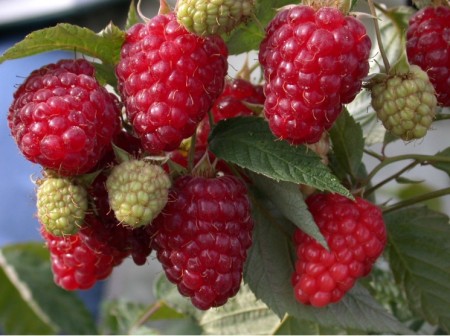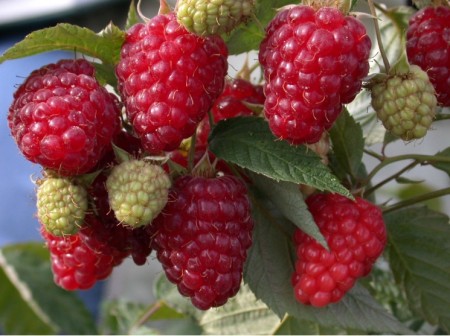Amateur gardeners often praise the Brilliantovaya variety of remontant raspberries: large-fruited, productive, tasty. Some people plant these raspberries in their plots and anxiously await the harvest. Unfortunately, not everyone’s expectations are met.
In almost all cases, the cause of failure is incorrect agricultural technology. Many gardeners plant and care for Diamonds the old fashioned way, as they are used to planting ordinary raspberries: a shallow trench, a little compost, a little mineral water. And the result is complete disappointment
An intensive variety requires no less intensive agricultural technology. Otherwise, don't expect success.
Planting raspberries
- Diamond raspberries should be planted in the sunniest place possible. Even the slightest shading leads to a decrease in yield and delays the ripening of berries in the fall.
- The best time to plant these raspberries is the middle and second half of October.
- Do not cover the root collar with soil. It should be level with the soil surface.
- On sandy ones, you can deepen them by 3-5 cm. Deeper planting inhibits the development of plants and the appearance of offspring. Seedlings may die.
- Planting too shallow can lead to drying out of the roots and freezing in winter.
- The holes for planting are made with a diameter of 30-35 cm and a depth of 25-30 cm. 1-2 buckets of organic matter and 4-5 tablespoons of complex mineral fertilizer are added to each planting hole.
How to care for raspberries
Nutrition is no less important. Diamond grows and bears fruit well only on fertile soil, in black earth regions. Clay soil must be fertilized abundantly with organic matter.
When preparing a trench, add 1 sq. m of allocated area 2-3 buckets of humus or compost and a glass of complex mineral fertilizer with microelements. Mineral fertilizers can be replaced with wood ash: a liter jar per 1 sq. m.
Diamond raspberries require a mandatory garter, because their shoots tend to bend towards the ground during the fruiting period.
Its berries are large, one-dimensional - from 4 to 7 g, dark red in color, shiny. Tasting rating of berries - 4 points.They ripen from mid-August until frost.
From one bush you can collect from 4 to 7 kg of berries. But the advantages of this raspberry are fully manifested only under the condition of proper agricultural technology: optimal nutrition and regular watering.
As with other remontant varieties, in the fall (in the second half of November), all annual shoots of the diamond are cut to the ground, leaving no stumps. Early pruning is unfavorable for it. Before the soil freezes, the roots receive from the leaves of the shoots the nutrients the plants need next year for growth and crop formation.
Reproduction
This raspberry variety can be successfully propagated by cuttings. It produces many root shoots. They can be cut when they reach 5 cm (no more) and the leaves remain red. Cuttings with green leaves take less root.
The cut cuttings are planted with a lump of earth in pots or in a permanent place, if it is possible to care for them daily: water, loosen the soil, slightly shade from the sun. The seedlings take root well and produce a good harvest in the first season.
Author of the article T. Tavolgina



 CUCUMBERS NEVER GET SICK, I'VE BEEN USING ONLY THIS FOR 40 YEARS! I SHARE A SECRET WITH YOU, CUCUMBERS ARE LIKE THE PICTURE!
CUCUMBERS NEVER GET SICK, I'VE BEEN USING ONLY THIS FOR 40 YEARS! I SHARE A SECRET WITH YOU, CUCUMBERS ARE LIKE THE PICTURE! You can dig a bucket of potatoes from each bush. Do you think these are fairy tales? Watch the video
You can dig a bucket of potatoes from each bush. Do you think these are fairy tales? Watch the video
 How our fellow gardeners work in Korea. There is a lot to learn and just fun to watch.
How our fellow gardeners work in Korea. There is a lot to learn and just fun to watch. Eye trainer. The author claims that with daily viewing, vision is restored. They don't charge money for views.
Eye trainer. The author claims that with daily viewing, vision is restored. They don't charge money for views. A 3-ingredient cake recipe in 30 minutes is better than Napoleon. Simple and very tasty.
A 3-ingredient cake recipe in 30 minutes is better than Napoleon. Simple and very tasty. Therapeutic exercises for cervical osteochondrosis. A complete set of exercises.
Therapeutic exercises for cervical osteochondrosis. A complete set of exercises. Which indoor plants match your zodiac sign?
Which indoor plants match your zodiac sign? What about them? Excursion to German dachas.
What about them? Excursion to German dachas.